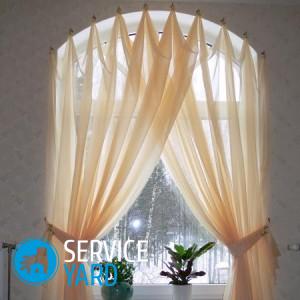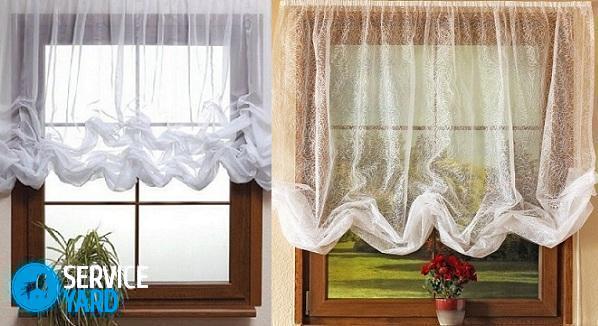Do-it-yourself Austrian curtain - master class

Recently, the theme of design for a home is especially relevant. Given modern technological capabilities, a variety of materials, the main thing is to choose the right idea, and you can create a new interior at least every year so that the house does not turn into an ordinary box for existence. Austrian curtains are also gaining more and more popularity in the decor. But to make the design unique, you can sew an element such as an Austrian curtain with your own hands. You will find a master class in this article.
to contents ↑What are Austrian curtains?
Before talking about how to sew this decor element correctly, we need to figure out what it is and what it has in mind:
- Such curtains are a mixture of French curtains that are distinguished by their splendor, while they work like Roman ones.
- The bottom is usually made out of them with the most diverse drapery that imagination can allow.
- And the material of execution suggests a more decorative role, as it is translucent and does not protect from prying eyes and direct sunlight.
Decoration Benefits
In order to determine for yourself all the advantages of Austrian curtains, you need to re-read a lot of information about them. Among the main and well-known, we can distinguish the following:
- Easy to use. In order to slightly open the window or close it to the required length, you just need to pull on the cord system. Some exclusive options generally involve only pressing a couple of buttons, since they work from an automatic mechanism.
- Easy to clean. Thanks to the fabric that is used to sew this decor element, there is no accumulation of dirt and dust on it. And when this happens, removing such a thing is quite simple.
- Application area. Such curtains will decorate not only the living room or bedroom, but are also well suited for other rooms in your house, even for the kitchen.
- Do-it-yourself Viennese curtains have the advantage of being a unique and unique element of decorating your home.
to contents ↑Important! Despite all the advantages, they also have their drawbacks. Among them:
- Limited by style. In minimalism and high-tech style are not used.
- Fabrics transmit light and heat. So - the curtains do not protect you from the sun's rays and curious prying eyes.
Sewing preparation
It is possible to make almost any option of curtains or curtains with your own hands, and Austrian curtains are the simplest of them, since they do not require the creation of an additional layer of paintings.
Before you start sewing curtains, you need:
- Choose fabric and curtains to match.
- Choose an option for drapery.
- Take measurements of the window.
Instruments
Tools to be prepared:
- Sewing machine.
- Ruler, measuring tape.
- Needles and pins.
- A piece of chalk.
- Threads in tone of fabric.
- Scissors.
Choose a fabric
The choice of fabric is a rather difficult task for such an element as an Austrian curtain. Sewing it yourself is quite simple only with a successful choice of the base fabric.
Important! Lightweight, wrinkled fabrics are best suited for your task. Density and transparency remain entirely your choice, depending on the functionality of the curtains. The color scheme is also chosen at your discretion.
But the most successfully and expensively look Viennese curtains with their own hands precisely from plain materials. A few tips for choosing:
- Organza, chiffon, tulle and veil look easy and weightless. They let in a lot of light and are easily draped.
- Synthetic and iridescent fabrics look festive and beneficial in the interior. These include silk, thick satin and brocade.
- For rooms in the style of Country, Provence, it is better to use materials such as linen, satin, chintz.
- If there is a need to use heavy fabrics, then velvet and wool are good for this.

Drapery
There are many options how to make a drapery for such an element of the interior. Among them there are those where the cord or elastic is threaded by hand. But, as a rule, a specialized braid is used, which can be purchased at any sewing store.
What else you need to know about the braid:
- It looks like a strip of transparent material, through which several thin laces are passed. The optimal number is 2. But there are options with one and three.
- This element is sewn to the curtain in the place where the fold should end. So - on the sides of the curtains and after each fold.
- If you don’t cut the braid after drapery, but tie it on a bow, you can periodically open it and get an even cloth. It is convenient during washing.
- The length of the braid should be to the end of the curtain, while starting 5-7 cm from the top.
Decor
The edges of the Austrian curtains are very diverse. In order to make this decor element presentable, use:
- Ruffles.
- Shuttlecocks.
- Fringe.
- Lace.
- Braid.
- Tassels.
- Beads and beads.
- Weights - if the material is light enough and does not stretch under the weight of the festoons themselves.
Pattern
When we already have all the necessary materials at our disposal, we must also determine the size of the canvas itself. To do this, measure such quantities as:
- The width of the cornice.
- The height of the window.
The calculation of the width and height of the material required for sewing should be done according to the following recommendations:
- The width of the pattern should be equal to the width of the cornice plus an increase in the hem. As a rule, about 3-4 cm are left for allowances, but this largely depends on the texture of the fabric.
- The length of the product is usually calculated by the formula: the height of the window opening is multiplied by two.
Important! The height size largely depends on the interior of which room Viennese curtains will be decorated with their own hands. For example, for a kitchen, the optimal size would be the height of the window plus another maximum meter. This is done due to the fact that too lush folds in the kitchen room quickly collect dust and dirt.
- The lower allowance is usually left from 10 to 20 cm. This is done so that even when expanded, the curtains have an assembled structure at the bottom.
- The pattern itself is a rectangle that is divided into separate parts by stripes. These stripes indicate the location of the curtain webbing. The step between them is usually a width of 30 to 50 cm.
to contents ↑Important! In specialized stores you can find specialized braid for Roman curtains, it is ideal for us, since it already has rings sewn to itself.
Sewing curtains with your own hands
Now that we have done all the necessary preparations — we’ve acquired the materials, prepared the tools and made the pattern, we can start sewing the curtains. If the following points are perfectly followed, then such an element as an Austrian curtain can be sewn by itself quite simply:
- We take a piece of fabric of the size we need and be sure to steam it with an iron. This is done so that after washing the shrinkage of the curtains does not spoil the entire appearance of the product.
- Now using the pattern, we outline with chalk the places in which the curtain braid should run.
- Next we attach the side bend.
- We take the ribbons of the braid and with a basting seam we sew it to the previously designated places. Sew the side ribbons as close as possible to the hem.If your tape is not specialized, then first you should sew rings to it, and then sew the tape itself.
- Iron the resulting work with an iron.
Important! The upper part of the Viennese curtains with their own hands always remains flat. Therefore, not in all cases you need to sew the tape to the very top. This is done only in cases where it is planned to make an automatic mechanism for lifting the curtains.
- We attach the braid to the already ironed product.
- Now we draw up the top of the product: we take the threads to match the fabric and attach the top of the product wrapped about 5 cm.
- Now we sew the curtain tape - on the front side exactly along the seam made earlier.
- Further, turning the tape inside out, we attach it again. For unknowing only one straight seam will be visible.
- After each stitching, it is advisable to iron the product - so it will have a more accurate appearance, will not twist and take unnecessary folds.
to contents ↑Important! It remains only to decorate the bottom of the product at your discretion. What to use for decoration is up to you, but keep in mind - curtains with weighting agents hang more evenly and look better. Typically, such weights are sewn to the bottom of each assembly tape.
Care
Caring for these products is a pleasure. In order to wash them, it is enough to use a washing machine and follow a few simple rules for care:
- Cleaning should be fairly regular.
- Before washing the curtains, you need to remove, straighten and put in a special bag.
- The washing mode should be delicate, and the water temperature should not exceed 30 degrees.
- Drying such products is best in suspension, and after drying - iron.
Stock footage
Do-it-yourself Austrian curtain is an excellent addition to most modern style solutions. Sewing such a product requires effort and patience, but the craftswoman will enjoy the result of her labor for a long time, and the room with such curtains will fully correspond to the temperament of her mistress.
- How to choose a vacuum cleaner taking into account the characteristics of the house and coatings?
- What to look for when choosing a water delivery
- How to quickly create comfort at home - tips for housewives
- How to choose the perfect TV - useful tips
- What to look for when choosing blinds
- What should be running shoes?
- What useful things can you buy in a hardware store
- Iphone 11 pro max review
- Than iPhone is better than Android smartphones



